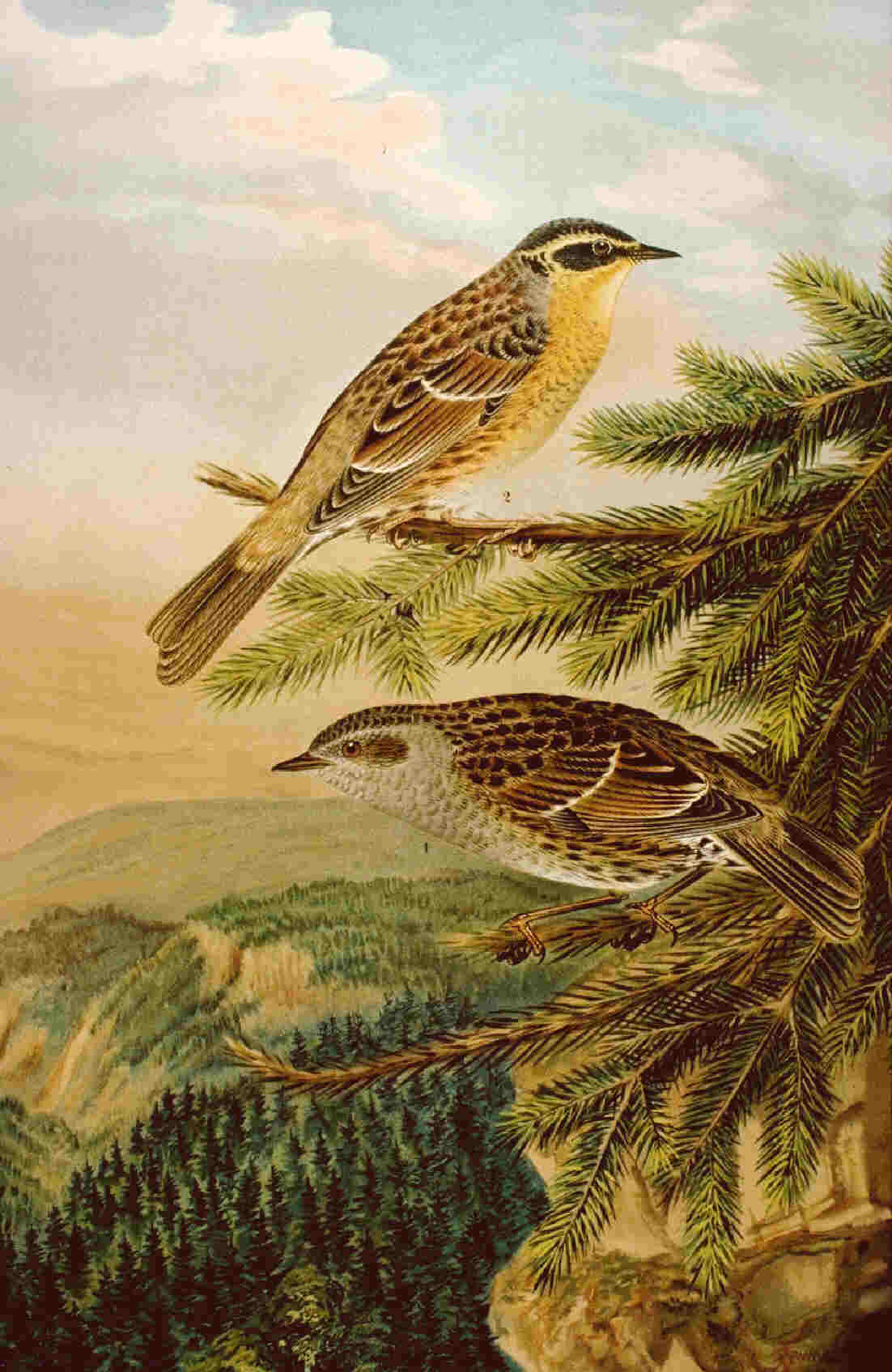- Accentor
image_width = 240px
image_caption = "P. montanella" (top) and "P. modularis" (bottom)
regnum =Animal ia
phylum = Chordata
classis = Aves
ordo =Passeriformes
subordo =Passeri
familia = Prunellidae
familia_authority = Richmond, 1908
genus = "Prunella"
genus_authority = Vieillot, 1816
subdivision_ranks = Species
subdivision = See text.The accentors are in the only
bird family, the Prunellidae, which is completely endemic to thePalearctic . This small group of closely relatedpasserine s are all in a single genus "Prunella". All but the Dunnock and the Japanese Accentor are inhabitants of the mountainous regions of Europe and Asia; these two also occur in lowland areas, as does the Siberian Accentor in the far north of Siberia. This genus is not strongly migratory, but they will leave the coldest parts of their range in winter, and make altitudinal movements.These are small, fairly drab species superficially similar, but unrelated to,
sparrow s; they are generally regarded as being related to thethrush es or thewarbler s. They are 14 to 18 centimetres in length, and weigh between 25 and 35 gramscite book |editor=Forshaw, Joseph|author= McClure, H. Elliott|year=1991|title=Encyclopaedia of Animals: Birds|publisher= Merehurst Press|location=London|pages= 184|isbn= 1-85391-186-0] . However, accentors have thin sharp bills, reflecting their diet of ground-dwelling insects in summer, augmented with seeds and berries in winter. They may also swallow grit and sand to help their stomach break up these seeds. cite book|title=The Funk & Wagnalls Wildlife Encyclopedia|author=Burton, Maurice and Burton, Robert|date=1974|publisher=Funk and Wagnalls|volume=1|location= New York, N.Y.|oclc=20316938]Their typical habitat is mountainous regions in an area far above the tree-line, but below the snow-line. The Himalayan accentor can be found as high as 17,000 ft above sea level when breeding, however, most accentors breed in scrub vegetation at lower levels. Most species migrate downwards to spend the winter, with only some being hardy enough to remain. Accentors spend the majority of their time in the undergrowth and even when flushed, stay low to the ground until reaching cover.
Most of the species live together in flocks, like other members of Prunellidae. The dunnock is an exception since it prefers to be solitary except when feeding. The dunnock also earned a nickname of "shuffle-wing" since it most strongly displays the characteristic wing flicks used during courtship and other displays.
Accentors may have two to three broods a year. Courtship consists of a great deal of song from the males, which may include short lark-like song flights to attract a mate. In most species, the male and female share in the nest making, with the dunnocks again being an exception - their males have no part in nest building or incubation. They build neat cup nests and lay about 4 unspotted green or blue eggs. The eggs are incubated for around 12 days. The young are fed by both parents and take an additional 12 days or so to fledge.
pecies list
FAMILY: PRUNELLIDAE
* Genus: "Prunella"
**Alpine Accentor , "Prunella collaris "
**Altai Accentor , "Prunella himalayana "
**Robin Accentor , "Prunella rubeculoides "
**Rufous-breasted Accentor , "Prunella strophiata "
**Siberian Accentor , "Prunella montanella "
**Brown Accentor , "Prunella fulvescens "
**Radde's Accentor , "Prunella ocularis "
**Black-throated Accentor , "Prunella atrogularis "
**Koslow's Accentor , "Prunella koslowi "
**Dunnock orHedge Accentor orHedge Sparrow , "Prunella modularis "
**Japanese Accentor , "Prunella rubida "
**Maroon-backed Accentor , "Prunella immaculata "Harrison [Harrison, "An Atlas of the Birds of the Western Palaearctic", 1982] used the group name Dunnock for all of the species, not just "Prunella modularis" (thus e.g. Japanese Dunnock for "P. rubida"); this usage has much to be said for it, based as it is on the oldest known name for any of the species (old English "dun"-, brown, + -"ock", small bird: "little brown bird"), and a much more euphonious name than the contrived "Accentor". "Accentor" was the scientific name for the Alpine Accentor ("Accentor collaris"). It comes from
Late Latin , meaning "sing with another" (ad + cantor).References
External links
* [http://ibc.hbw.com/ibc/phtml/familia.phtml?idFamilia=136 Accentor videos] on the Internet Bird Collection
Wikimedia Foundation. 2010.

